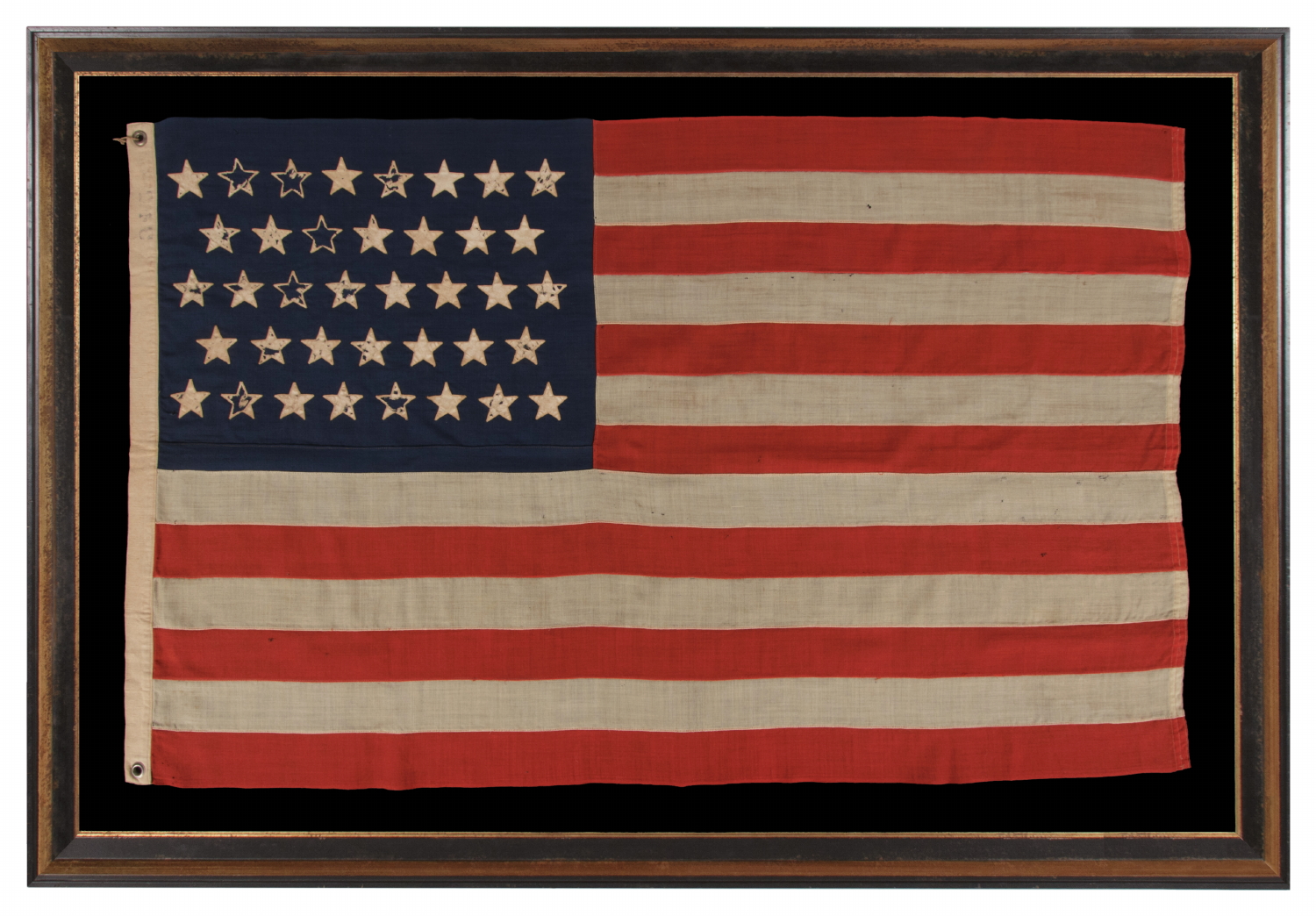
| |
38 STARS WITH ENDEARING WEAR ON AN UNUSUALLY SMALL PIECED-AND SEWN ANTIQUE AMERICAN FLAG OF THE 1876-1889 PERIOD, REFLECTS COLORADO'S ADDITION TO THE UNION |
|
| Available: |
Sold |
| Frame Size (H x L): |
Approx. 49.5" x 70.5" |
| Flag Size (H x L): |
36.75" x 58.25" |
|
| Description....: |
|
38 star American national flag in an unusually small scale for a pieced-and-sewn flag of the period in which it was manufactured. Colorado became the 38th state on August 1st, 1876. This was the year of our nation’s 100-year anniversary of independence.
Per the Third Flag Act of 1818, stars were not officially added until the 4th of July following a state's addition. For this reason, 37 was the official star count for the American flag in 1876. Flag-making was a competitive venture, however, and few flag-makers would have been continuing to produce 37 star flags when their competitors were making 38’s. It is for this reason that 38 and 13 stars (to represent the original 13 colonies) are more often seen at the Centennial International Exposition, the six-month long World’s Fair held in Philadelphia in honor of the event. Some flag-makers would have been adding a star for the 38th state even before it entered the Union, in the early part of 1876 or even prior. In fact, many makers of parade flags were actually producing 39 star flags, in hopeful anticipation of the addition of two more Western Territories instead of one. But the 39th state would not join the Union for another 13 years, when the Dakota Territory entered as two states on the same day. The 38 star flag became official on July 4th, 1877 and was generally used until the addition of the Dakotas in 1889.
President Ulysses S. Grant was in office when the first 38 star flags would have appeared. Rutherford B. Hayes had replaced him in the White House by the time the star count became official, and the remaining list to serve the nation during the 38 star era include James Garfield, Chester Arthur, Grover Cleveland, and Benjamin Harrison.
During the 19th century, flags with pieced-and-sewn construction (as opposed to printed) were typically eight feet long or larger. This is because they were important in their function as signals, meaning that they needed to be seen and recognized from a great distance. Even flags made for decorative purpose were generally very large by today’s standards. A small flag was six feet in length and this particular example measures just under five feet on the fly. Since the average 19th century sewn flag can be cumbersome to frame and display in an indoor setting, many collectors prefer printed parade flags and smaller sewn flags, like this one, the size of which provides a good balance between visual impact and versatility.
The stars of the flag are made of cotton and are double-appliquéd (applied to both sides) with treadle stitching. These are arranged in staggered lineal rows in counts of 8-7-8-7-8. All of the stars are oriented in an upright position (with one point up). The stripes and canton of the flag are made of wool bunting that has been pieced with treadle stitching, which is typical of the period. There is a canvas binding along the hoist with two white metal grommets, the uppermost of which retains and small length of hemp rope. The numerals "3" and "5" are stenciled in black along the binding to indicate size in feet. Note how these are separated by a Maltese cross instead of an "x," which was typical of one or more flag-makers that have yet to be identified.
The colors of the flag are strong and pleasing, but the best visual characteristic results from the losses in the stars, which shows its age gracefully and has an endearing appeal that some connoisseurs of early American flags--myself among them--sincerely enjoy from an artistic standpoint, as well as a patriotic one.
Mounting: The flag was mounted and framed in our own conservation department, which is led by expert trained staff. We take great care in the mounting and preservation of flags and have framed thousands of examples.
The background is 100% cotton twill, black in color. The black-painted, hand-gilded and distressed molding is Italian. The glazing is U.V. protective Plexiglas.
Condition: There are losses in a most of the stars, accompanied by minor foxing and staining. There is very minor soiling elsewhere in the flag and there is a scattering of tiny holes, but the overall condition of the canton and stripes is remarkable for a wool flag of this period that has survived into the 21st centery. The black stencil has significantly faded. Many of my clients prefer early flags to show their age and history of use. |
|
|
|
| Collector Level: |
Intermediate-Level Collectors and Special Gifts |
|
| Flag Type: |
Sewn flag |
|
| Star Count: |
38 |
|
| Earliest Date of Origin: |
1876 |
|
| Latest Date of Origin: |
1889 |
|
| State/Affiliation: |
Colorado |
|
| War Association: |
1866-1890 Indian Wars |
|
| Price: |
SOLD |
|
| |
Views: 959 |
|
|
|

